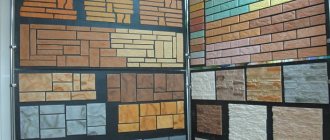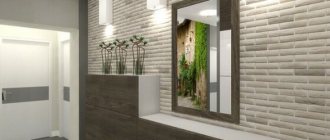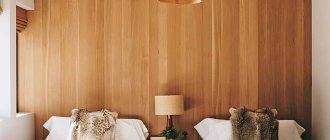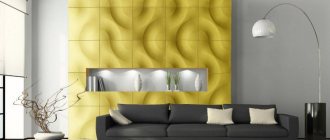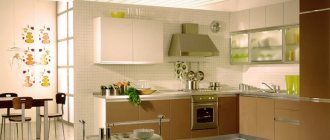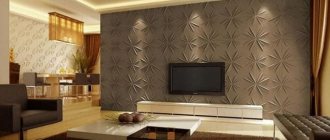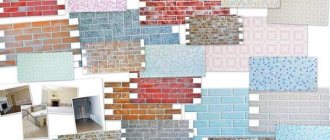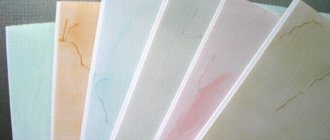How are soft wall panels made and can this be done at home? Let's take a closer look at 2 methods of making such panels, after which you can make such a miracle yourself at home. In addition, I will tell you about the intricacies of working with materials and reveal some of the secrets of the masters.
Soft finishing in the living room will make the interior warmer and more comfortable.
Installation of ready-made soft wall panels
The installation process is similar to working with any other wall panels. There are 3 options for mounting products on the wall:
- Using glue.
- On the frame.
- Using fastening elements.
Each option has its own characteristics.
Fixation with glue
This option is simple. The advantage is the speed of work, the usable space of the room is not lost. However, the walls need to be carefully prepared and leveled. The installation process is as follows:
- The surface is plastered and primed.
- Markings are made on the surface for each panel in order to orientate and stick everything evenly.
- Glue is applied to the back of the panel. There is no need to apply it to the wall. The application line is not straight, but zigzag.
- All that remains is to glue the panel in place. It's better to start from the bottom and work your way up. The products are tightly fixed to each other.
Frame mounting
To fix it on the wall, a frame made of metal or wood is formed. Slats are used. The advantages of this method are that the wall does not need to be prepared, and insulation can be laid in the space between the slats or communications can be hidden. When the frame is ready, the panel is placed in place and fixed at the edges to the slats, and in the middle to the wall.
Fixation to fastening elements
This is the optimal finishing with soft panels. The work uses liquid nails or dowels. When fixing the panels to the wall, they are tightly attached to each other so that there are no gaps. Otherwise, dust and dirt will get there, and it will be quite difficult to remove it.
This completes the work. The room has been transformed and looks noble. However, in order for it to continue to remain this way, the soft panels need to be looked after. The surface is cleaned with a vacuum cleaner or microfiber cloth. As for leatherette or leather, wet cleaning with a soft cloth is allowed. Required: regularly remove dust, if moisture gets in, immediately blot with a sponge or cloth, use special care products, but under no circumstances use chemicals, hair dryers or other heating devices. And in order not to damage the material, it is better not to rub the surface with force. By doing all this, there is no doubt that the finish will last for many years and will look gorgeous for decades.
Glass
In the manufacture of this type, tempered glass is used, which is durable and wear-resistant. The glass version of the panels is varied. Their surface can be either matte or smooth glossy. 3D panels in the bedroom are considered new.
Modern versions of glass coatings can imitate various natural materials, such as stone, brick, wood, etc. They can be equipped with lighting, which will advantageously emphasize the uniqueness of the room and make the room more spacious.
The only negative that may be present during operation is the formation of stains, smudges or fingerprints on the glass. To avoid them, you will have to carefully care for the material.
Wooden panels
An interesting option for wall decoration is cladding with wood panels. Wood is an environmentally friendly natural material and looks very beautiful. The wooden wall in the bedroom can be of any shade, with patterns or plain.
Manufacturers make panels of any size and shape. The wood is treated with special compounds, so there is no need to worry about damage to the material. Advantages of panels:
- Unusual and varied design;
- Suitable for interior cladding not only of walls, but also of ceilings;
- There is no need to prepare the surface before installation;
- A wooden wall helps hide the unevenness of the wall;
- Retains heat and does not allow noise to pass through;
- It’s easy to install the panels yourself;
- Wooden flooring is easier to maintain;
- You can hide unnecessary elements and wires behind the cladding.
An original idea for wall cladding is eco-friendly bamboo panels
They do not accumulate dust and do not cause an allergic reaction, which is especially important for the bedroom. If desired, you can add decor from stone or other natural materials to the wood
PVC
The most popular and affordable ones today are plastic ones. A huge range of models, various colors, a variety of shapes, patterns and sizes allow you to choose PVC panels.
But you shouldn’t rush, since you can’t forget about the harmful effects of all kinds of impurities and compounds. This can happen when heated, and then the fumes from the plastic will cause irritation to the eyes and respiratory organs.
Installation of soft walls in Capiton style
Capiton is a slightly more complicated version of the panel on a full-size, durable base. The quilted upholstery here is decorated with braid and buttons, emulating the luxury of a 19th-century European royal interior.
This style is not applicable to frame panels. The base is initially marked for tension points. Then holes are drilled in these places, stuffing and upholstery are attached and the fabric is pulled through the holes. This is usually done using large round buttons covered with the same fabric as the entire panel.
The panel is attached to the wall using quick-setting liquid nails under the building level or according to pre-drawn markings.
How to attach soft wall panels
No special skills are required to attach the panels. The main thing is to correctly mark the surface so that the panels lie evenly vertically and horizontally.
There are several ways to attach soft wall panels.
Gluing panels to the wall
Tools and materials
- primer
- brush
- glue liquid nails or PVA
- glue gun
- level
- tape measure, pencil
- foam sponge
- hacksaw
- scotch
• Select the panel layout option. Small panels are attached close to each other or at a distance of 5 to 15 cm.
• Prime the plastered or puttied wall. The primer allows you to remove dust from the surface and improve the quality of adhesion of the panels to the wall.
• Use a level and pencil to mark the wall.
• Apply glue to the back surface of the panel. PVA glue is applied with a brush over the entire surface or in zigzags. Liquid nails are applied using a gun in dots or a zigzag line along the edges of the tile and in the center. Make sure that the glue does not get on the front side of the panel - you can ruin the panel. Do not apply the glue too close to the edge of the panel - when installing the tiles, it will squeeze out and stain the side of the panel. If glue gets on the material, remove it immediately with a damp sponge.
• Press the panel firmly against the wall following the markings. The panels can be glued in any direction - from top to bottom, or from the bottom of the wall. If the panels reach the ceiling, it is better to start installing the panels from the ceiling.
• Side panels that do not fit are cut with a hacksaw. Unfasten the material around the edge. Saw off part of the solid base with a hacksaw. Cover the cut area with tape. Fold the material over and secure it with a stapler.
Trimmed panels don't look very nice. It's okay if the panels don't reach the corner. The main thing is that the distance from the last panel to the wall is the same on both sides.
To glue the panels to the wall, you can use a special adhesive tape - double-sided tape. The cattle are glued to the dust-free wall. Then the protective film is removed and the panel is pressed tightly against the wall. Before pressing the panel, make sure that the panel is located strictly according to the marks without distortions. Gluing panels with tape works well for lightweight panels with a smooth base. Plywood does not stick very well to such tape.
Fastening panels using magnets
Ready-made panels from LuxWall are produced with a magnetic fastening system. Magnets are attached to the panel. Magnets do not affect the operation of electronics. The gravity system is sufficient to support the weight of the panel. The number of magnets depends on the weight of the panel.
Metal strips are installed on the wall, and panels are attached to them using magnets.
Soft wall panels LuxWal. Photo.
Covering a wall with a frame
One of the methods for creating soft panels is covering a frame fixed to the wall with a material with a backing.
• Install a frame made of wooden slats.
• Glue the space between the slats with foam rubber. The foam rubber is easily glued to PVA glue.
• Secure the padding polyester over the slats with a stapler. The material should not lie on the slats without a backing.
• Secure the edge of the material to the top rail.
• Using even tension, secure the material to the bottom and side rails.
• Glue decorative tape where the fabric is attached to cover the staples.
• Cover furniture nails with material.
• Using a hammer, carefully nail the nails into the sheathing. To avoid damaging the material on the nails, place a piece of padding polyester and drive the nail into it.
Fastening panels with dowel-nails
Large panels with a backing thickness of 3 cm or more are attached in this way.
• Drill with a wood drill bit. plywood on panel
Be careful not to drill through the panel
• Mark where the panel will be attached to the wall.
• Use a hammer drill to make holes in the wall. Drive in the dowel nails and insert the screws.
• Align the holes on the panel with the fasteners on the wall and hang the panel.
The panels can also be fastened with self-tapping screws to wooden sheathing. With this method, the material on the panel is detached. The panel is attached at the corners with self-tapping screws to the slats, then the material is wrapped over the edge of the panel. The disadvantage of this method is that it is difficult to do the job accurately.
Some companies produce self-adhesive panels. The wall under such panels should be smooth and free of dust. Prime the surface. Separate the protective film from the adhesive base. Press the panel tightly against the wall.
A good lesson is how to make a carriage tie. Video in Portuguese. But all the actions are shown so clearly and clearly that the video is understandable even without knowledge of the language.
Wall decoration with fabric.
https://youtube.com/watch?v=FOHHVcLhdtI
Design and installation features
Panels for soft-format walls can be fixed using a locking mechanism or on a frame made of wooden slats. In the first case, installation is quite simple: the finished product is put on a pre-prepared sheathing (in the case of light-weight piece parts, an adhesive composition is used). In the second case, everything is much more complicated: first, a wooden frame with cells is constructed and attached to the selected surface, inside which a special noise-absorbing material is placed, then the whole canvas is covered with an intermediate middle layer (foam rubber or others), then the upholstery covering with decorative elements is stretched , hiding all visible joints.
The soft wall panel is assembled from parts covered in different leathers, milky and white.
Methods for installing soft panels on walls
Factory-made or self-made products can be mounted on walls in various ways, which we will discuss below.
Fixing soft panels to the wall with glue
Before attaching soft wall panels to the wall with glue, you need to choose the option for their location on the surface and make the appropriate markings using a building level and a pencil. In addition to them, for the work you will need liquid nails or PVA glue, a tape measure, a hacksaw, a foam sponge and tape. The wall must have a dry surface plastered and primed.
The work should be done in this order:
- You need to apply glue to the back of the soft panel. If it is PVA, then it is applied to the entire surface with a brush, liquid nails - with dots or a zigzag along the edges of the base and in its center. Glue should not get on the front of the product, as this can damage it. If this happens, the composition should be immediately carefully removed with a damp sponge.
After preparing the panel, it should be pressed against the wall according to the markings made. Pasting can be done from bottom to top or vice versa. If the surface is decorated up to the ceiling, it is better to start installing the panels from the top.
Side panels that do not fit can be cut with a hacksaw. To do this, you should detach the material from the edge of the product, saw off part of the base, seal the cut area with tape and, wrapping the covering on the back side of the panel, secure its edge with staples. Cut soft decorative panels for walls do not always look beautiful. If they don't touch the corners, it's okay. The main thing is the same distances from the outer slabs to the opposite walls.
It is convenient to glue lightweight panels with a smooth base using double-sided tape. It should be glued to the wall, the protective layer should be removed and the panel should be pressed tightly against the wall. Before doing this, you need to make sure that the product is positioned according to the markings.
Fastening a soft panel to a wall on a frame
A soft panel can be made and mounted on the wall using a frame. This is done like this:
You need to install a frame with a cellular structure on the wall. The material for it can be wooden slats. Their fastening should be done using dowels, which are installed in pre-prepared holes according to the markings. A hammer drill is used for drilling.
Then the cells of the frame should be filled with foam rubber, which is easily glued to the wall with a PVA compound.
You need to fasten the synthetic padding polyester over the frame with a stapler, and then fix the edge of the front covering of the future panel on the top rail.
Evenly stretching the material, you should secure its edges to the side and bottom slats of the frame.
The fastening points must be taped with decorative tape to disguise them.
After this, you should cover the furniture nails with fabric and nail them to the sheathing. To avoid damage to the material during this procedure, nails must be driven through padding pads.
Installing a soft panel on the walls using fasteners
Large soft wall panels with a base thickness of three centimeters are mounted using a hinged method.
- Work should begin by drilling recesses in the plywood to allow the product to be hung on fasteners. You need to be careful in this process so as not to accidentally drill through the panel.
After this, you need to measure the distances between the recesses and project them onto the wall, taking into account the height of the panel. The resulting fastening points should be marked on the wall with a pencil.
Then at these points you need to make holes using a hammer drill, drive dowels into them and screw in screws.
By combining the fasteners on the wall with the recesses in the base of the panel, you can hang the product. To ensure reliability, the drilling site can be reinforced with metal plates.
In addition to the above methods of attaching soft panels, there are magnetic systems and self-adhesive bases. In the first case, the panels are equipped with magnets that have sufficient power to support the weight of the products. Depending on it, the number of magnets is determined. Metal strips are mounted on the wall on which such a panel is installed. One of the popular manufacturers of these models is LuxWall.
Panels with a self-adhesive backing require a smooth, clean, primed wall surface. During installation, the protective film is removed from the base of the panel, and the product itself is pressed tightly and fixed to the surface.
In everyday life, any model is quite unpretentious - you just need to remove dust on time. The only thing that can be dangerous for finishing walls with soft panels is contact with hard objects. An accidental blow from the corner of the furniture can damage the panel. To restore it, you will need the help of a specialist.
How to attach soft panels to walls - watch the video:
The ability to create soft volumetric decorative elements gives the design of premises unlimited potential. At the same time, over time, such panels become simpler, lighter, more diverse and cheaper. Good luck with your work!
Color combinations
Stylists advise taking into account the following nuances:
- direction in the interior;
- combination of shades;
- illumination
It is much easier to choose a palette if the style for the kitchen and living room has already been selected. For example, neoclassicism and Provence have their own combinations. In a classic interior, designers combine pastel colors, pale colors, which are slightly diluted with dark shades. In French country houses you can often see soft blue, pink, and pistachio colors. Art Deco designers make up objects and finishing materials in black and white, sometimes beige and brown or silver and black. The main thing is to choose a shade for the walls. White will become universal, it will expand the space, and later you can paint them with any paint. However, in the cooking area, white ceases to look fresh. Beige or gray shades would be more practical. This background will highlight the other colors. In a monochrome interior, designers recommend gluing wallpaper in an unusual color or with a photo print.
How to make soft wall panels yourself - 2 ways available to the home craftsman
For several decades now, soft wall panels have remained one of the most popular materials, both for wall decoration and in the manufacture of furniture. It is believed that the production of soft panels requires expensive equipment and appropriate qualifications. Next we will try to debunk this myth and you will learn how to make such a coating simply, quickly and at minimal cost.
Soft wall panels harmonize well with any type of interior.
Panel arrangement
Whatever the decorative panels, their structure is approximately the same. Initially, a rigid base is taken, which can be sheets of fiberboard, MDF, chipboard or something similar. As a rule, foam rubber with a thickness of 10 mm to 100 mm is glued to this sheet. After which all this is covered with leather, leatherette or fabric.
Now there are several types of such coating, some models are truly exclusive and it is not possible to make them at home with your own hands. So in the photo below you see soft 3D wall panels. They certainly look impressive, but trying to make them at home is useless; special machines are needed here.
Making 3D wall panels with your own hands is impossible.
Making soft panels for walls with your own hands at home has certain features; from experience I can say that there are 2 relatively simple models that a home craftsman can handle - these are smooth soft panels and panels made using the carriage screed method, which will be discussed further below. there will be a speech.
Carriage screed is considered one of the most popular and impressive types of wall panels.
Selecting materials for panels
The range of applications for soft panels made of leather or fabric is huge, starting with small ottomans with a soft seat and ending with solid decoration for cafes and other similar places, but the use of such finishing in the interior is a big topic worthy of a separate article.
Soft walls and furniture in a cafe are beautiful and practical.
Now we are talking about the applied direction, and any work on the manufacture of anything begins with the selection of materials.
- Basis - here it all depends on the purpose for which you are making your panel. So, for furniture, for example, headrests for beds, MDF, chipboard or OSB boards with a thickness of about 10 - 12 mm are taken. Plywood works well, but is more expensive. Pure wall cladding or lining of entrance doors should not be too thick, so such panels are made on the basis of thin plywood or fiberboard,
- The filler or backing is responsible for softness and volume. As already mentioned, this often includes furniture foam up to 100 mm thick. Although there are some smooth models that are filled with padding polyester and even batting. For example, if you make yourself a soft ironing board, then it is filled only with batting,
Furniture foam rubber is the most practical backing for soft panels.
The list of finishing materials for such panels consists of 3 points:
- Making soft wall panels covered with natural leather is a good option, but very expensive. After all, finely tanned leather is used for these purposes, and its price is high; not everyone can afford such a coating,
- Furniture fabrics, especially velvet, look impressive, but are difficult to care for. The more you vacuum and wash the fabric covering, the faster it will become unusable.
- Leatherette wall panels now occupy approximately 50–70% of the market. This material combines the best price with decent quality. Plus, you can wash artificial leather as much as you like.
The choice of eco-leather furniture is now huge.
Important: now all companies specializing in the production of soft panels use so-called eco-leather, in principle it is the same leatherette, only of very high quality. Visually, eco-leather is practically indistinguishable from natural leather, plus it stretches well and does not burn
Method number 1. How to make a smooth panel
In this case, no special preparation of the wall surface is required, because the panel is made separately and what you will attach it to next is not so important. The only requirement is that the walls be dry and free of fungus, and for this they can be covered with a layer of antiseptic, for example, the same copper sulfate
How to make soft wall panels yourself - 2 ways available to the home craftsman
How to make soft wall panels yourself - 2 ways available to the home craftsman For several decades now, soft wall panels have remained one of the most popular materials, both for
MDF
MDF panels are made from compressed wood chips, which are specially treated with antiseptic substances.
The material is quite affordable, meets environmental standards and meets the technical requirements of finishing. It is often used as a basis for further painting or painting.
Master class No. 3 “headboard in carriage style”
Carriage tie or capitonne is a fairly common method of furniture decoration, inspired by the way carriages were finished in the 18th century. This is a soft upholstery fastened with rivets to the base, forming a pattern in the form of squares or diamonds. This decor looks aristocratic, bringing a feeling of comfort and stability to the interior of the bedroom.
For this type of headboard decoration, it is best to choose heavy, expensive fabric that forms luxurious folds.
- leather – natural or artificial;
- velours;
- velvet;
- faux suede.
These are dense materials capable of forming distinct, beautiful folds - they are the goal. The fabric may have a pattern that matches the design of the image being created. Therefore, light fabrics with simple patterns are completely unsuitable for carriage screeds.
The following materials are used for screeding:
- buttons covered with fabric;
- massive beads;
- crystals.
Buttons can be matching or contrasting - both methods give their own unique effect. Classic contrasts of black and white in the art deco style are good. You can use fabric rose buttons together as a romantic element.
Materials and tools for work:
- a sheet of plywood or a board with holes;
- foam rubber 50 mm thick;
- padding polyester;
- knife;
- rubber glue;
- thick paper;
- strong thread;
- large needle;
- marker;
- buttons;
- thick fabric;
- furniture stapler;
- electric jigsaw;
Using quilted panels in individual rooms
Quilted soft panels can be used almost anywhere.
In the living room they will fit perfectly behind the TV. Thanks to this, the room will lose the feeling of emptiness and sterility, which are often in harmony with a futuristic interior. In the bedroom, they are usually used to create a comfortable headboard or soft walls for the bed.
In the kitchen, as you know, sometimes something boils over, sometimes grease splashes. An incredibly successful solution turned out to be wall panels that can be easily wiped with a cloth. In addition, they perfectly highlight ingenuity and design.
In the bathroom, they prove to be a great alternative to conventional wall panels, but before you decide to install soft panels for the bathroom, check before purchasing whether they are water and moisture resistant.
They can be used in many different ways in a child's/youth room. For example, you can use them as a padded wall to create a safe and cozy play area for your child, or simply use them as a headboard for a bed.
In an entryway, hallway or dining room, they can be a great decoration due to the lack of space for any functional or decorative elements. The small panel takes up little space and produces a wow effect.
In an office/study, an upholstered wall is a fantastic idea to create an elegant style in it.
Features of soft wall panels
The wall panels are not only beautiful, soft and comfortable, but also have many practical functions such as sound insulation and heat insulation. They can be made to order or made by hand, and miraculously change the interior of the room.
Currently, such panels are used to decorate walls not only in the bedroom, but also in the living room or on an insulated balcony with a sleeping area, although most often they are used to decorate the wall behind the bed.
Thanks to the huge variety of options, you can create any design and give the room a luxurious look for a relatively small amount of money. The upholstery can be chosen from various materials such as silk, linen, velvet, velor, leather and other types of materials. All these elements are used to create wall panels. The choice of material depends entirely on the owner’s imagination and the overall style of the home’s interior.
It is important to choose the right lighting that will highlight the color and texture of the fabric. Light colors will make the room more voluminous, while dark colors will create an intimate atmosphere. Soft wall panels look great in bedroom interior design. They radiate warmth and comfort
Related article: How to properly decorate walls with fabric
Advantages of soft wall panels
- An excellent way to soundproof. Also used for thermal insulation and covering of wires.
- They give the room an unusual and exclusive look. Thanks to the huge range, they are suitable for rooms of any type.
- Installation is very simple and only takes a few hours. Excellent ability to hide flaws and defects in walls.
- You won't find better material for arranging a children's room. Since the panels are made from environmentally friendly materials, they are safe.
- Goes well with other types of wall decoration. They allow you to focus on various interior items, which will certainly decorate your home.
- Panels can be made in various shapes and configurations - rectangular, square or unusual, depending on the location.
- Panels made from durable materials, such as leather, have excellent wear resistance and practicality.
- They also have very good resistance to mechanical stress, which determines their long service life.
Materials from which soft panels are made
- Genuine Leather. The most expensive type of panels. Its advantage lies in the excellent combination of the material with wallpaper of various textures and colors. Looks luxurious with leather and wood furniture. But it is quite problematic to use.
- Leatherette. The choice of panels from this material must be approached seriously. It must be durable, high quality and reliable. Caring for such panels is simple; they can be wet cleaned.
- Panels made of fabric (textile). The fabric must be durable, this will serve for a long time, and the appearance will remain presentable. An excellent option would be upholstery fabric for furniture. If you want to create a soft panel yourself, then textiles will be an excellent choice.
They are considered a universal solution for interior decoration. They can be made of silk, linen, viscose, jacquard, suede, velor and other types of fabric. They have many color options, selected depending on the design of the room.
Foam rubber
Most often used for children's rooms. It creates a panel of great thickness, making the walls soft and safe for the child.
Sintepon
Lightweight material, which allows you to create a uniform panel surface. Panels made of padding polyester are resistant to deformation.
Conclusion
Now in stores, ready-made soft wall panels cost from 5,000 rubles per 1 m², but you received instructions according to which you can do everything yourself and several times cheaper. If after watching the video you still have questions, welcome to the comments, I will help in any way I can.
How to attach soft wall panels
No special skills are required to attach the panels. The main thing is to correctly mark the surface so that the panels lie evenly vertically and horizontally.
There are several ways to attach soft wall panels.
Gluing panels to the wall
Tools and materials
- primer
- brush
- glue liquid nails or PVA
- glue gun
- level
- tape measure, pencil
- foam sponge
- hacksaw
- scotch
• Select the panel layout option. Small panels are attached close to each other or at a distance of 5 to 15 cm.
• Prime the plastered or puttied wall. The primer allows you to remove dust from the surface and improve the quality of adhesion of the panels to the wall.
• Use a level and pencil to mark the wall.
• Apply glue to the back surface of the panel. PVA glue is applied with a brush over the entire surface or in zigzags. Liquid nails are applied using a gun in dots or a zigzag line along the edges of the tile and in the center. Make sure that the glue does not get on the front side of the panel - you can ruin the panel. Do not apply the glue too close to the edge of the panel - when installing the tiles, it will squeeze out and stain the side of the panel. If glue gets on the material, remove it immediately with a damp sponge.
• Press the panel firmly against the wall following the markings. The panels can be glued in any direction - from top to bottom, or from the bottom of the wall. If the panels reach the ceiling, it is better to start installing the panels from the ceiling.
• Side panels that do not fit are cut with a hacksaw. Unfasten the material around the edge. Saw off part of the solid base with a hacksaw. Cover the cut area with tape. Fold the material over and secure it with a stapler.
Trimmed panels don't look very nice. It's okay if the panels don't reach the corner. The main thing is that the distance from the last panel to the wall is the same on both sides.
To glue the panels to the wall, you can use a special adhesive tape - double-sided tape. The cattle are glued to the dust-free wall. Then the protective film is removed and the panel is pressed tightly against the wall. Before pressing the panel, make sure that the panel is located strictly according to the marks without distortions. Gluing panels with tape works well for lightweight panels with a smooth base. Plywood does not stick very well to such tape.
Fastening panels using magnets
Ready-made panels from LuxWall are produced with a magnetic fastening system. Magnets are attached to the panel. Magnets do not affect the operation of electronics. The gravity system is sufficient to support the weight of the panel. The number of magnets depends on the weight of the panel.
Metal strips are installed on the wall, and panels are attached to them using magnets.
Soft wall panels LuxWal. Photo.
Chipboard
Chipboard panels also use wood as a natural fiber for processing. It is pressed using different temperature conditions. Several high temperatures interact simultaneously, resulting in a fairly durable and safe material. They can safely decorate children's bedrooms without worrying about the health of their child.
Fixing to walls is carried out in several ways:
- Apply special glue directly to the treated flat surface.
- Self-tapping screws or other fastenings to a pre-prepared sheathing.
Important! Before laying the panels, it is advisable to treat the walls with an antiseptic, as well as a moisture-resistant solution. It wouldn’t hurt to additionally coat the surface with an antifungal compound.
